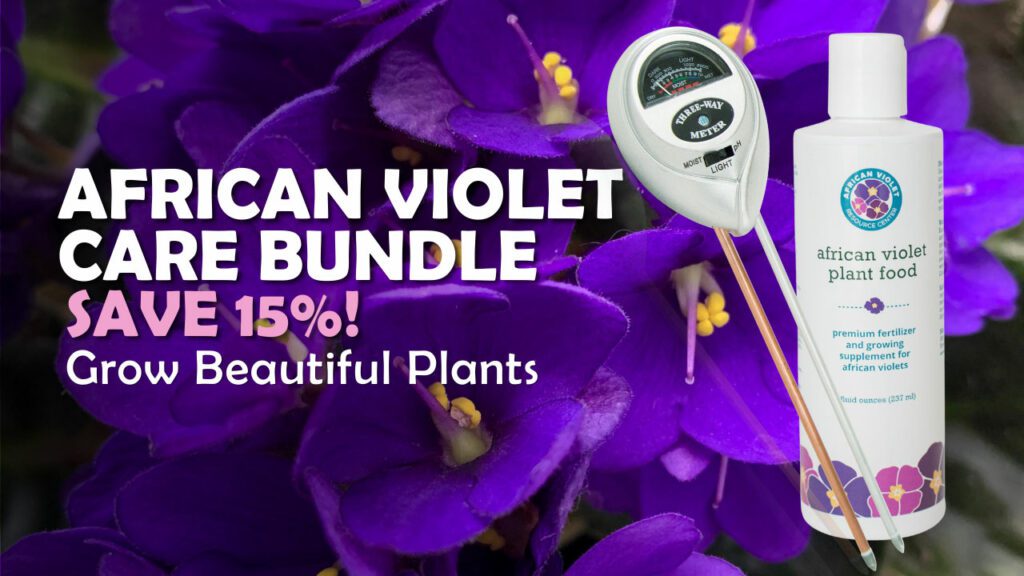Caring for an African violet—or any living creature, for that matter—is a big responsibility. You are the keeper of health, the bringer of blooms, a benevolent bestower of beauty. And nothing throws that sense of duty into panic mode like a struggling houseplant.
If you’ve arrived here asking, “How do I revive my African violet?!” you’re in the right place. This helpful guide outlines several common African violet problems and solutions; so you can feel confident and capable no matter the crisis.
How to Pick the Perfect African Violet
Preventing African violet problems starts with selecting a healthy, vigorous plant from the get-go. However, African violets are not your standard single-variety species; with a stupendous array of colors, shapes, and characteristics, the choice can be overwhelming. You’ll also want to be on the lookout for certain markers that indicate a plant will grow strong and beautiful. Keep an eye out for the following qualities to set yourself up for success from day one:
- Symmetrical shape: Although you can remedy a lopsided plant by angling thinner sections toward the sun, we recommend choosing an African violet with fairly even growth to save yourself the headache.
- Healthy leaves: Droopy, depleted leaves are a sign an African violet is in poor health. Look for vigorous, dark green leaves and avoid any plants with brown, black, or white spots. We recommend checking for signs of pests as well. Look for bites, bugs, and egg sacs before buying.
- Ample buds: I mean, you’re buying this baby to bloom, right? Purchasing an African violet with numerous closed buds increases the chances you’ll enjoy more flowers in the future.
- Color coordinate: Decide ahead of time what color violet will complement your home. This can prevent overwhelm at the nursery when you realize, “Erhm, they come in how many colors?!”
Once you select the prettiest plant at the ball, the rest is up to you. The following guide breaks down everything you need to know about identifying common African violet problems—and what to do next.
Common African Violet Problems
While it might seem daunting to determine what’s gone wrong, you can usually narrow it down to a few key culprits. The list below covers common symptoms, pests, and remedies to help you get your African violet back to its best.
Houseplant Pro Tip: The best way to prevent African violet problems is to give them the proper care from day one. Check out 3 Steps to Mastering the Art of African Violet Care for a few valuable tricks and tips.
4 Common African Violet Leaf Problems
Pale or Bleached Leaves
If you notice your plant’s leaves are losing their lush, green color, get it out of the sun! These delicate houseplants are sensitive to direct light and will discolor when overexposed. Move your plant to a spot away from harsh, direct sunlight. (Just make sure it’s still well-lit!)
Long, Spindly Leaves
African violets usually stick pretty close to the soil. If your plant starts to grow tall, thin leaves, it is receiving insufficient sunlight. It is, in fact, literally reaching for the light. The solution: Move your plant to a brighter area of your home.
Spots on Leaves
Uh oh! Unfortunately, many novice gardeners learn the hard way that African violet leaves shouldn’t get wet. Exposure to moisture can cause a number of problems with your plant’s leaves, all marked by spots of different colors. For this reason, most people prefer bottom-watering methods. Here’s what you might see, and what to do about it:
- White spots: Wet leaves can develop white spots. If you notice this African violet problem, gently rub the leaves with a warm washcloth to remove the residue.
- Brown or yellow spots: Think of this symptom like frostbite or sunburn. Brown and yellow spots can be caused by cold water (again, this plant is sensitive!) or by wet leaves being exposed to the sun. Unfortunately, there’s no recovering from this African violet problem. Trim dying leaves—and stay dry in the future!
Curling, Brown Leaves
Fertilization is critical for your plant’s health. Over-fertilization? Not so much. Overfeeding can burn your African violet’s vulnerable root system, causing its leaves to curl and brown. If you notice these symptoms after fertilizing, immediately flush the soil with room-temperature water, taking care to avoid the leaves.
Providing African Violet Fertilization
Applying a gentle, liquid African violet fertilizer every time you water your plant is an excellent way to provide constant nutrients without the risk of over-fertilizing.
African Violet Problems: Pest Prevention & Treatment
Preventing Pests
African violets are susceptible to a number of plant pests. That’s why you should always keep enough distance between plants so that their leaves don’t touch. If you suspect one of your African violets has been infested, immediately isolate it from your other plants. This prevents the infestation from spreading and causing total houseplant chaos.
The best treatment is prevention: ALWAYS thoroughly clean and inspect new pots and plants before introducing them to your home. You should also wash your hands thoroughly before tending to your plants—yep, every time!
Mites
Mites are a common African violet problem. You may notice fine hairs growing from your plant’s leaves, leaves curling up around the edges, and new leaves growing pale instead of deep green. Grab a magnifying glass and look for tiny white, brown, or yellow insects in the crown or leaf creases.
Treating African Violet Mites
If you suspect your African violet has mites, immediately isolate it and treat with a houseplant-certified mite spray or natural insecticide.
Mildew
Mildew thrives in humid spaces with poor airflow. This white, dusty fungus looks like powdered sugar and can slow your plant’s growth or keep it from blooming.
Treating African Violet Mildew
First, remove all heavily infected buds and leaves. Dip a Q-tip in a 50% diluted rubbing alcohol solution and gently apply to any remaining infected areas. Another option is to apply a gentle fungicide to the rest of the plant. Prevent future mildew problems by placing your plant in a more aerated environment or near an oscillating fan.
Aphids
Yikes! What’s that sticky goo on your African violet’s leaves? It’s honeydew, my friend, and your plant has an aphid infestation. Where there’s honeydew, you’ll probably find small green, brown, or black aphids on your plant. Treat this African violet problem quickly: ants love honeydew, but houseplants don’t love ants.
Treating African Violet Aphids
Luckily, treating an aphid infestation is quite easy. Simply clean your African violet’s leaves gently but thoroughly with warm water and dish soap. (Check the undersides too!) If the problem persists, try a houseplant-friendly pesticide to finish the job.
Have an African violet problem we didn’t mention? Join the conversation in our Facebook group! (And take a deep breath; it’ll be okay!)
Join the African Violet Club!
Whether you’re just starting out or are a seasoned grower, African Violet Resource Center has everything you need to help you solve any African violet problem. Explore our other articles, visit our online shop, and connect with other houseplant lovers in our Facebook group to learn everything you need to know about this rewarding hobby!
More Great African Violet Resources
7 Reasons You Need an African Violet Houseplant NOW!
Bottoms Up! The Best African Violet Watering Methods for a Happy Houseplant
Endless Summer: Here’s How to Grow an African Violet Garden That BLOOMS







